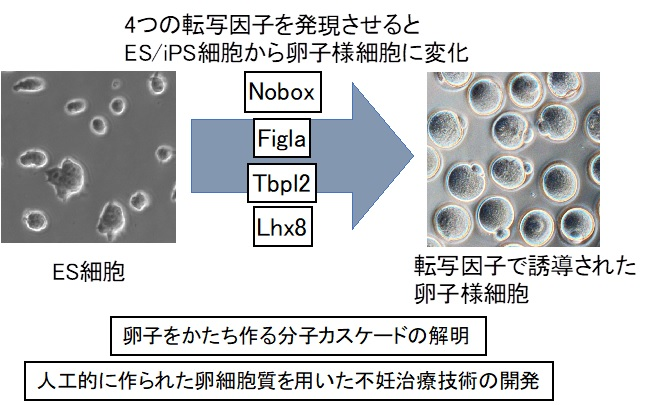
九州大学理化所:将细胞转化为卵的基因:iPS在不育症治疗中的应用
九州大学
使细胞“蛋”的基因:
我们已经鉴定出鸡蛋中形成特殊细胞质(卵质细胞质)所需的基因。
短时间内量产:
胚胎干细胞(ES细胞)
来自诱导多能干细胞(iPS细胞)
我们在短时间内成功地产生了大量带有卵细胞质的细胞(卵样细胞)。
该论文于20日在英国科学杂志《自然》上发表。
时事网
https://www.jiji.com/jc/article?k=2021012000257&g=soc
鉴定组成鸡蛋的基因
九州大学医学研究生院:林教授,滨崎助理教授(华盛顿大学),
RIKEN:北岛团队负责人
重新测试结果:
确定了一组形成小鼠卵的基因。
该基因组被引入胚胎干(ES)细胞并诱导多能干(iPS)细胞。
在很短的时间内,我们成功地产生了许多卵状细胞。
八个基因(转录因子):
我们仔细研究了制作鸡蛋的过程。
结果,我们鉴定了形成卵细胞质所需的八个基因(转录因子)。
出奇:
当八个基因在ES细胞和iPS细胞中表达时,
细胞质迅速生长,
它变成具有受精能力的卵状细胞。
在短时间内大量生产:
与以前相比,可以在更短的时间内产生大量的“具有生物学和医学价值的卵细胞质”。
由于这项成就:
“阐明个体发育必需的卵细胞质的形成机制”和
期望“开发利用人工卵细胞质的不育治疗技术”。
研究结果:
它于2020年12月16日(星期三)16:00(英国标准时间)发表在国际学术期刊“自然”上。
九州大学
https://www.kyushu-u.ac.jp/ja/researches/view/538
Nature volume 589, pages264–269(2021)
Cite this article 15k Accesses 1 Citations 543 Altmetric Metrics details
Reconstitution of the oocyte transcriptional network with transcription factors
Abstract
During female germline development, oocytes
become a highly specialized cell type and form a maternal cytoplasmic store of crucial factors.
Oocyte growth
is triggered at the transition from primordial to primary follicle and is accompanied by dynamic changes in gene expression1, but the gene regulatory network that controls oocyte growth remains unknown.
Here we identify a set of transcription factors that are sufficient to trigger oocyte growth.
By investigation of the changes in gene expression and functional screening using an in vitro mouse oocyte development system,
we identified eight transcription factors, each of which was essential for the transition from primordial to primary follicle.
Notably, enforced expression of these transcription factors
swiftly converted pluripotent stem cells into oocyte-like cells that were competent for fertilization and subsequent cleavage.
These transcription-factor-induced oocyte-like cells were formed without
specification of primordial germ cells, epigenetic reprogramming or meiosis,
and demonstrate that oocyte growth and lineage-specific de novo DNA methylation are separable from the preceding epigenetic reprogramming in primordial germ cells.
This study
identifies a core set of transcription factors for orchestrating oocyte growth, and provides an alternative source of ooplasm, which is a unique material for reproductive biology and medicine.
Nature